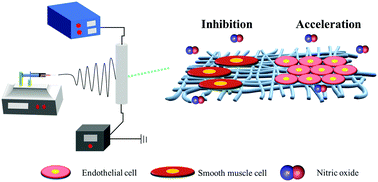Fabrication of PCL/keratin composite scaffolds for vascular tissue engineering with catalytic generation of nitric oxide potential†
Abstract
Tissue-engineered vascular grafts (TEVGs) have been proposed as a promising approach to fulfill the need for small-diameter blood vessel substitutes. However, common failure caused by thrombosis and neointimal proliferation after implantation has restricted their use in the clinic. Herein, a NO-generating scaffold for vascular tissue engineering was developed by coelectrospinning poly(ε-caprolactone) (PCL) with keratin. The morphology and surface chemical composition were characterized via SEM, ATR-FTIR spectroscopy and XPS. The biocomposite scaffold selectively enhanced the adhesion and growth of endothelial cells (ECs) while suppressing the proliferation of smooth muscle cells (SMCs) in the presence of GSH and GSNO due to the catalytic generation of NO. In addition, these mats displayed excellent blood compatibility by prolonging the blood-clotting time. In summary, these NO-generating PCL/keratin scaffolds have potential applications in vascular tissue engineering with rapid endothelialization and reduced SMC proliferation.



 Please wait while we load your content...
Please wait while we load your content...